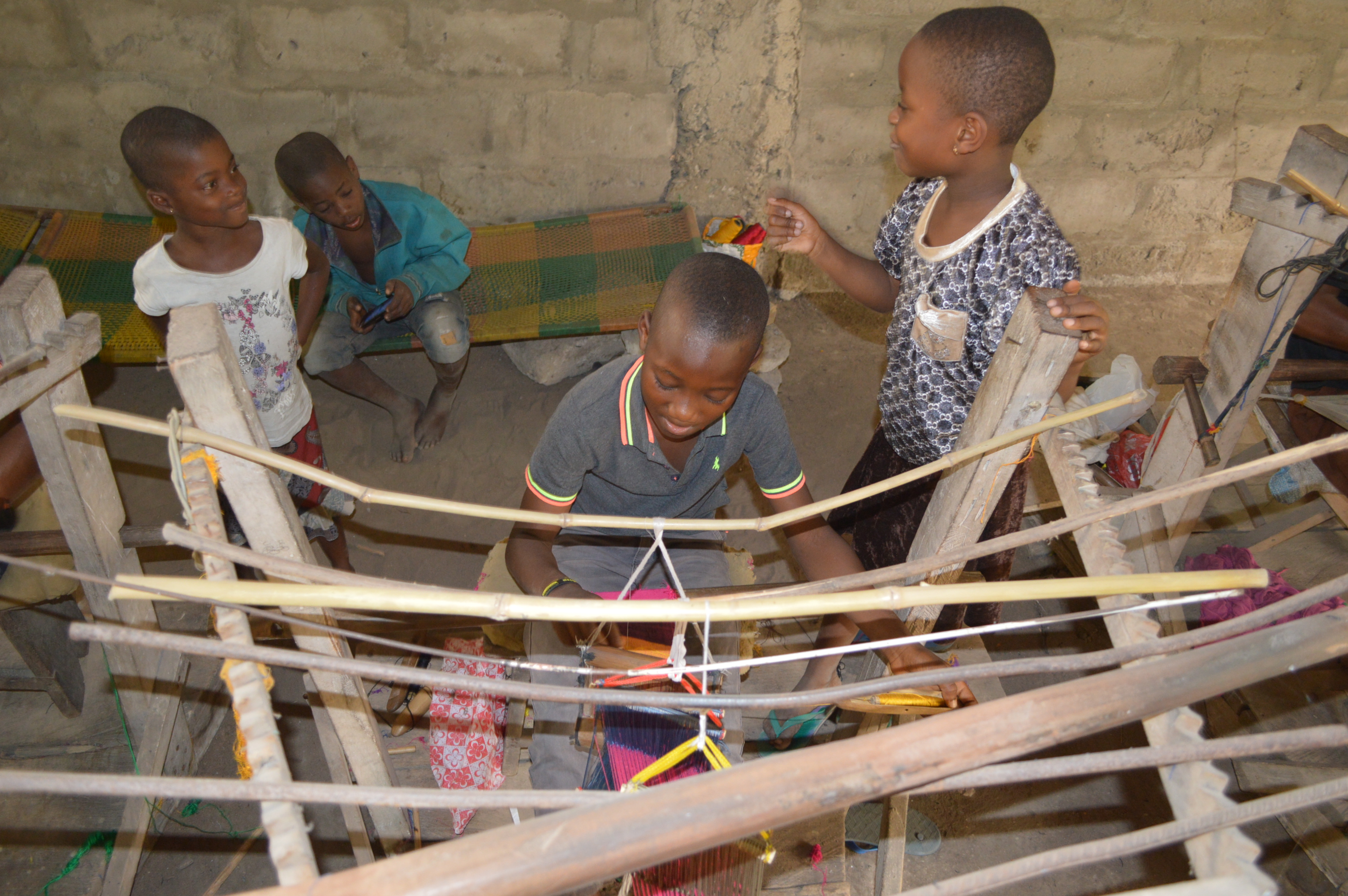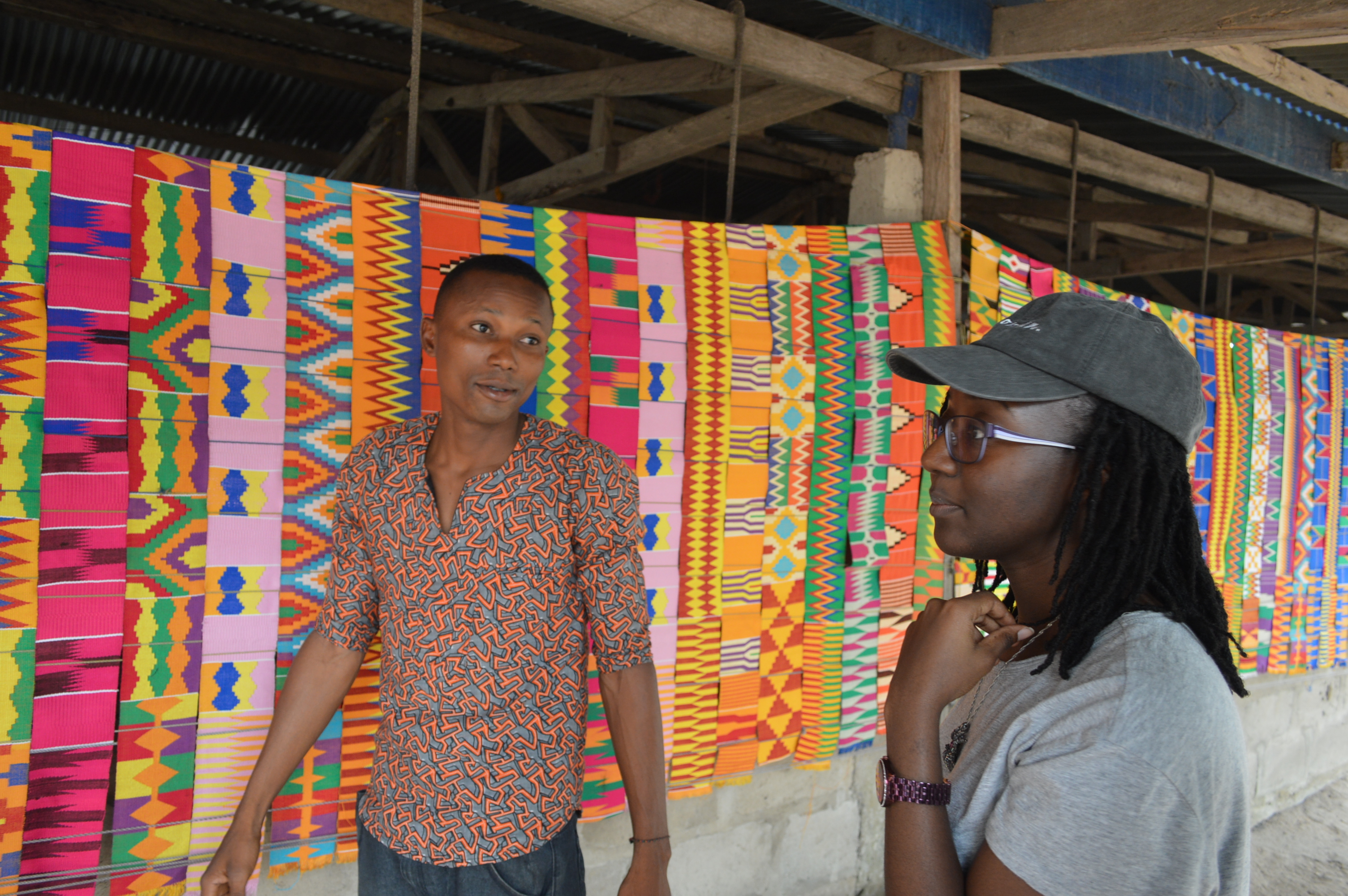[Here’s the link to Part 1, although you don’t need to have read that before this.]
After our visit to this small kente shop, we went running around Agortime-Kpetoe, which is basically Weavers’ Central. Weavers work either individually – whether outside or in their homes – or in large, communal spaces furnished with looms and really long stretches of thread held down by heavy stones. I’ve never been to Bonwire or any other weaving center, so I’ve never even seen Asante kente being woven. I found myself glad my first witnessing of live-weaving was in the Volta Region. (It has a lot to do with my position on Twi-ification.)
One of the places we passed through in Agortime-Kpetoe was a “kete” training center, one of those large rooms with several looms. The signboard was right in front of the building, and naturally caught my eye because on it, I saw what I had been expecting for some time but hadn’t yet come across: the omission of the “n” from the word kente, in what I believe is more exclusively Ewe style.
We didn’t meet many weavers, because most people were on break from Bronya season, but we did meet the young man whose family business this particular institution was. For the purposes of this public post, let’s call him Mawuli. Mawuli and a bunch of kids (which could have been his own, but I didn’t ask), sat casually weaving even though they didn’t quite have to work during the holiday. I estimate the kids’ ages between 4 and 9. They were already pretty great artisans, skillfully navigating that complex loom, to the surprise of my mother in particular. Recognizing how impressed she was, they became so eager to show off their skills that they almost started fighting over the already-threaded loom they had previously been taking turns on.

The patterns Mawuli and the kids were weaving were incredibly vibrant and colorful, and apparently very different from what my Kumasi-raised mother had been expecting.
“Ah, is this also Ewe kente?” she asked.
“You are thinking of the style that is closer to the batakari…” Mawuli realized.
She acknowledged that that is what she’d always assumed to be real Ayigbe kente.
I think several people imagine it as more boring, less resplendent and eye-catching, than Bonwire kente. The vibrancy of what we were seeing produced now, as well as the burst of color we’d seen at the Ho retailer, did not compute with those erroneous notions. And even though I knew for sure I’d already gone on a rant about this during one family Sunday lunch, I began another one that moment. (Let me confess: I did a lot of research before I felt comfortable enough to write “Kuukua and the Killjoy Kente”. But it should be common knowledge that 98% of research done for a story ends up being irrelevant for that particular tale. The knowledge in a writer’s head thus starts eagerly pulsating, on the lookout for any opportunity to make itself relevant. This was one such opportunity.) I started talking plenty about how Ewe kente is actually far less constrained to fixed patterns than Asante kente.
Mawuli listened to our conversation with interest for about a minute, then said, “Let me ask you something. Do you believe that story about some spider who taught people how to weave kente?” He said it with what I think was thinly-disguised disdain. I don’t think he was a fan of Akan kente folklore.
I told him, “I know that story, but I also know the Ewe one is different. I’ve heard that what actually happened is that the Asante kidnapped some master Ewe weavers, took them to their land, and made them teach the Akans how to weave kente.”
At this he nodded, evidently pleased with my answer, and then launched into the more detailed explanation of the Ewe origin lore:
Very early on, some Ewe men discovered that the logobo tree (I don’t know what plant this is, or if it has another name, or what it looks like) had bark very suitable for clothing. They then began experimenting with it. This idea of being modelled after tree patterns is meant to account, in a sense, for the initial, straight-lined patterns of what many people, like my mother, assumed to be the signature style of Ayigbe kente.
Over time, the creativity, exploration and ingenuity of the Ayigbe peoples eventually led to the art form in its much more colorful, imaginative and flexible state, and yes, some experts were at some point kidnapped and transported to Asanteland. This cultural exchange, perhaps more accurately described as an interaction, gave rise to the issue of the conflicting language attached to the craft.
The final product, the wearable, woven cloth produced by the art, is meant to be referred to as “agbamevɔ”. The word ke(n)te is a word merely referring to the technique. Although Akans will tell you something different, the kete name comes from the Ewe language itself. The art of weaving is primarily composed of two motions: “ke” meaning “to spread”/”to pull apart,” and “te,” meaning “to tighten”. Because of the language barrier, the Ewes could only teach the Asantes to weave by verbally communicating through the language they had brought with them. The weavers explained that in weaving, you first “ke” then “te” then “ke” and then “te” – but the Asantes, not quite comprehending the nuance, started to call the cloth itself “kente,” some sort of adulteration of the two originally Ewe words.
Or maybe they did it intentionally because “agbamevɔ” was too hard or too foreign. Who knows?
Another thing that seemed to be a very deep matter for Mawuli was the issue of fixed patterns and names. You may know already that Asante kente motifs are quite easily recognizable, and that if you know their names (and meanings), you will find it easy to identify what kind of kente motif a piece of cloth is when you see it. Not so with (at least a lot of) Ayigbe kente. Mawuli passionately reiterated again and again that many of the unfixed, unidentifiable patterns we were seeing were just “new, innovative designs,” (quoted verbatim) and should be respected as such, to honor the ingenuity of its legitimate creators. He was an unbeliever in what seemed to him to be stubborn, haphazard and baseless methods of naming new kete designs – especially naming after people he believed shouldn’t have any right to them. I forget his specific example, but it involved some European man arriving in Ghana, being presented with one of the Ewe’s “new, innovative designs,” and consequently having the motif named after him.

I have to admit, had I been a master weaver whose original Ayigbe sweat and tears ended up being called something like Jessica Eleanor Wattford-Longhorn, I would probably hex someone. (No offense if your name is Jessica Eleanor Wattford-Longhorn or similar.)

-Akotowaa





Leave a reply to debby000 Cancel reply